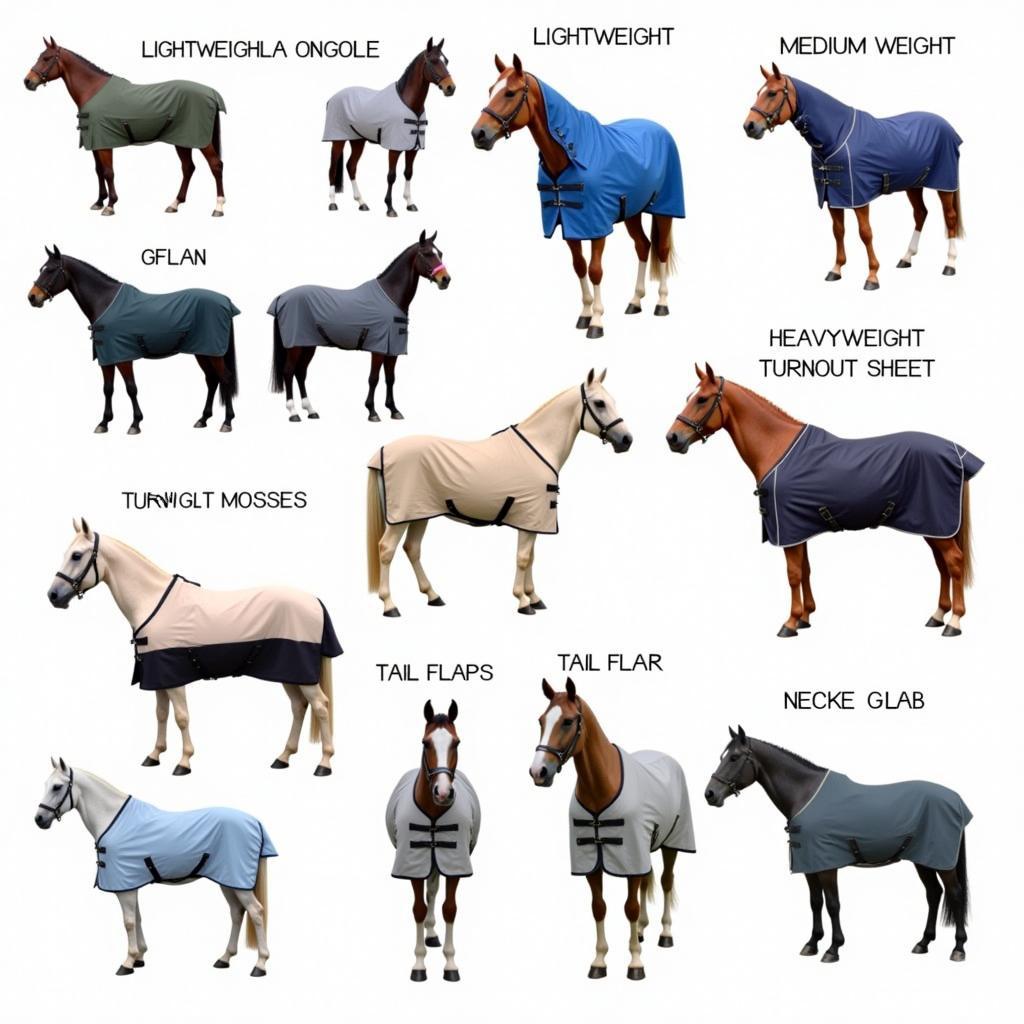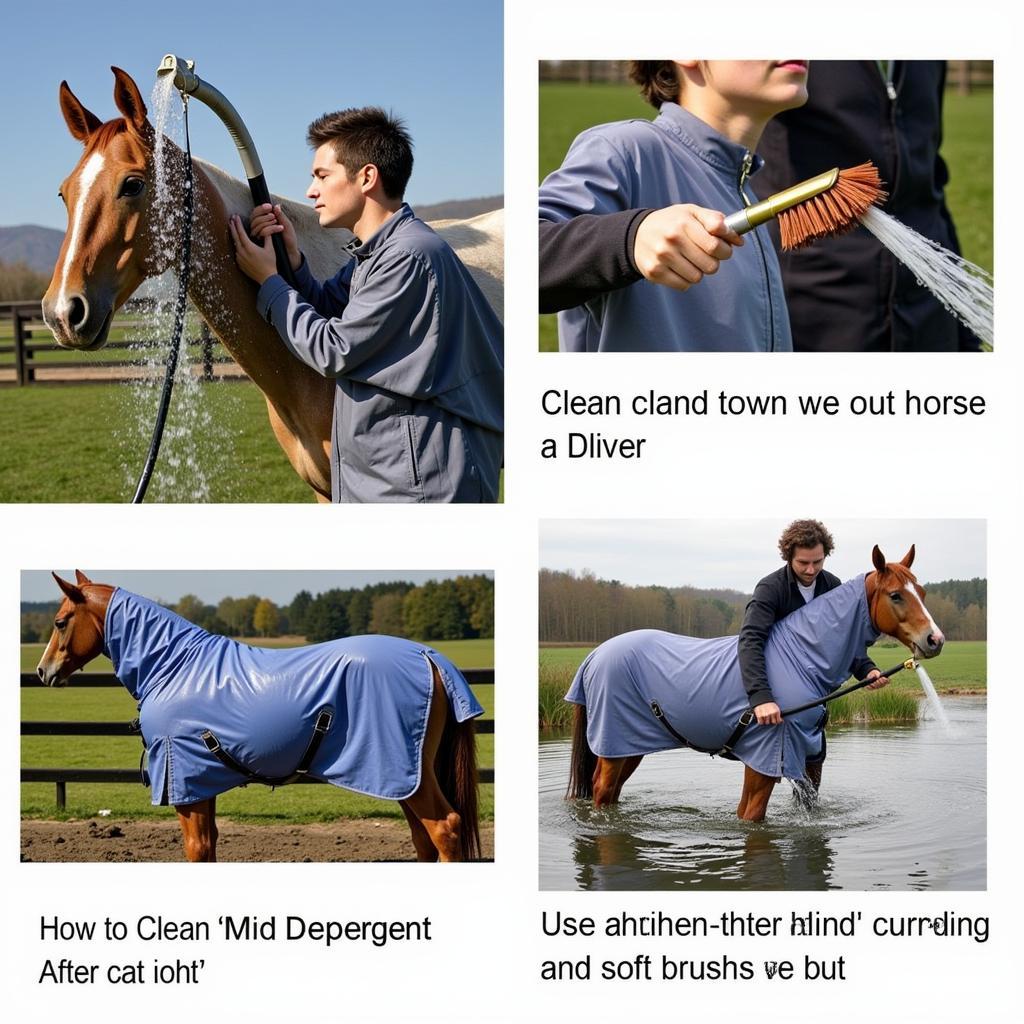Horse Rain Coats are essential for protecting your equine companion from the elements, ensuring their comfort and well-being during wet weather. Whether you’re riding in a drizzle or turning your horse out in a downpour, a good quality horse rain coat is a worthwhile investment. We’ll explore the different types of horse rain coats, the benefits they offer, and how to choose the perfect one for your horse. Choosing the right champagne horse for sale can be a delightful experience, and ensuring they’re properly protected from the weather is crucial for their health and happiness.
Why Your Horse Needs a Rain Coat
Horses, especially those clipped or with thinner coats, can be susceptible to chills and discomfort in wet weather. A horse rain coat acts as a barrier, preventing the horse’s coat from becoming saturated and heavy, which can lead to a drop in body temperature. This is especially important for older horses, horses recovering from illness, and those with compromised immune systems. Beyond keeping your horse dry, a good raincoat can also protect against strong winds and biting insects.
Benefits of Using Horse Rain Coats
- Maintain Body Temperature: Raincoats prevent the horse’s coat from getting wet and heavy, helping them maintain a comfortable body temperature even in chilly rain.
- Protection from Wind and Insects: A waterproof and windproof raincoat provides an extra layer of protection against the elements, keeping your horse warm and shielding them from biting insects.
- Faster Drying Time: By preventing the coat from getting soaked, a raincoat significantly reduces drying time after a rain shower.
- Cleanliness: A raincoat keeps your horse’s coat clean, reducing the need for extensive grooming after being caught in the rain.
 Horse wearing a rain coat in a paddock
Horse wearing a rain coat in a paddock
Types of Horse Rain Coats
There are several types of horse rain coats available, each designed for different purposes and weather conditions:
Lightweight Turnout Sheets:
These are ideal for light rain and warmer temperatures. They are typically made from breathable, water-resistant fabrics.
Medium-Weight Turnout Sheets:
These offer more protection in moderate rain and cooler temperatures, often featuring a lining for added warmth.
Heavyweight Turnout Sheets:
Designed for harsh weather conditions, these coats are made from durable, waterproof, and windproof materials and often include extra features like fleece linings for maximum warmth.
Stable Sheets:
These are designed to be worn indoors and can provide extra warmth in a cool stable. They are not typically waterproof.
When considering horses for sale in Montana, understanding the varying weather conditions is key to ensuring your horse has the right gear. A horses for sale in montana may need a more robust rain coat due to the unpredictable weather patterns.
Choosing the Right Horse Rain Coat
Finding the perfect horse rain coat requires careful consideration of several factors:
Size and Fit:
A properly fitted raincoat is essential for both comfort and effectiveness. Measure your horse accurately to ensure a snug fit without restricting movement.
Material:
Look for durable, waterproof, and breathable fabrics. Consider the climate and typical weather conditions in your area.
Features:
Features like adjustable straps, tail flaps, and leg straps can enhance the fit and functionality of the raincoat. High-neck designs offer additional protection against wind and rain.
 Different Horse Rain Coat Styles
Different Horse Rain Coat Styles
“A well-fitting raincoat is just as important for a horse as it is for a human,” says equine veterinarian Dr. Emily Carter. “It’s not just about keeping them dry, it’s about protecting their health and well-being.”
How to Care for Your Horse Rain Coat
Proper care will extend the life of your horse rain coat. Always follow the manufacturer’s instructions for cleaning and storage. Most raincoats can be washed in a washing machine with a mild detergent. Ensure the coat is thoroughly dry before storing it in a clean, dry place.
Cleaning and Storage Tips:
- Regularly brush off any dirt or debris.
- Repair any rips or tears promptly.
- Store in a well-ventilated area.
“Proper maintenance is essential for keeping your horse’s rain coat in top condition and ensuring its longevity,” advises professional horse groomer, Sarah Miller. “Regular cleaning and timely repairs can prevent minor issues from becoming major problems.”
 Cleaning a horse rain coat
Cleaning a horse rain coat
Conclusion
Investing in a high-quality horse rain coat is a crucial step in ensuring your horse’s comfort and protection during inclement weather. By understanding the different types of raincoats available and choosing one that fits properly and suits your horse’s needs, you can help keep your equine companion dry, warm, and happy. A comfortable horse is a happy horse, and with the right horse rain coat, you can be sure your horse is well-protected from the elements. Looking for an all black horse? Check out our selection and find your perfect equine partner. Understanding the difference between a paint vs quarter horse can be helpful when considering what activities you’ll be doing with your horse, and therefore what type of rain gear might be most suitable.
FAQ
- How do I measure my horse for a rain coat?
- What is the best material for a horse rain coat?
- How often should I wash my horse’s rain coat?
- Can a horse wear a rain coat in the stable?
- What are the different types of horse rain coats available?
- How do I know if my horse’s rain coat fits properly?
- Are there specific rain coats for different disciplines, such as attending a maryland horse and pony show?
When you need assistance, please contact us at Phone Number: 0772127271, Email: [email protected] or visit our address: QGM2+WX2, Vị Trung, Vị Thuỷ, Hậu Giang, Việt Nam. We have a 24/7 customer service team.